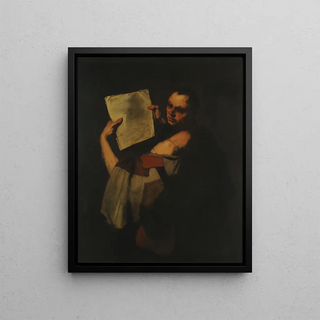Art print | An Astronomer - Jusepe de Ribera


View from behind

Frame (optional)
Art print Un astronomer by Jusepe de Ribera is a striking piece that transports viewers into a universe where science and art intersect. Painted in the 17th century, this work embodies the pursuit of knowledge characteristic of the Enlightenment era. In this depiction, an astronomer, immersed in his reflections, invites us to explore the mysteries of the cosmos while revealing the intensity of human emotions. The light, omnipresent, plays a fundamental role, illuminating the astronomer's face and creating a striking contrast with the surrounding darkness. This painting is not merely a frozen moment; it evokes an atmosphere of contemplation and wonder, inviting the viewer to share in this quest for truth.
Style and uniqueness of the art print
The uniqueness of "Un astronomer" lies in the masterful treatment of light and shadow, a technique that Ribera handles with brilliance. The chiaroscuro, typical of the Baroque, gives the scene a remarkable depth. The meticulous details, from the texture of the clothing to the pensive expression of the astronomer, demonstrate a particular attention to authenticity. The color palette, dominated by dark tones accented with luminous touches, creates an ambiance that is both mysterious and captivating. This art print is not limited to a simple depiction of a scholar at work; it becomes a metaphor for the pursuit of knowledge and humanity's place in the universe. The composition, balanced and harmonious, guides the viewer's gaze toward the face of the astronomer, emphasizing the importance of the individual in the face of the vastness of the cosmos.
The artist and his influence
Jusepe de Ribera, an emblematic figure of Spanish Baroque, was able to leave his mark on his era through his unique style and diverse subjects. Originating from Valencia, he was influenced by Italian masters, notably Caravaggio, whose chiaroscuro technique he adopted. Ribera is distinguished by his ability to capture the human essence, whether in religious figures, mythological scenes, or portraits. His

Matte finish

View from behind

Frame (optional)
Art print Un astronomer by Jusepe de Ribera is a striking piece that transports viewers into a universe where science and art intersect. Painted in the 17th century, this work embodies the pursuit of knowledge characteristic of the Enlightenment era. In this depiction, an astronomer, immersed in his reflections, invites us to explore the mysteries of the cosmos while revealing the intensity of human emotions. The light, omnipresent, plays a fundamental role, illuminating the astronomer's face and creating a striking contrast with the surrounding darkness. This painting is not merely a frozen moment; it evokes an atmosphere of contemplation and wonder, inviting the viewer to share in this quest for truth.
Style and uniqueness of the art print
The uniqueness of "Un astronomer" lies in the masterful treatment of light and shadow, a technique that Ribera handles with brilliance. The chiaroscuro, typical of the Baroque, gives the scene a remarkable depth. The meticulous details, from the texture of the clothing to the pensive expression of the astronomer, demonstrate a particular attention to authenticity. The color palette, dominated by dark tones accented with luminous touches, creates an ambiance that is both mysterious and captivating. This art print is not limited to a simple depiction of a scholar at work; it becomes a metaphor for the pursuit of knowledge and humanity's place in the universe. The composition, balanced and harmonious, guides the viewer's gaze toward the face of the astronomer, emphasizing the importance of the individual in the face of the vastness of the cosmos.
The artist and his influence
Jusepe de Ribera, an emblematic figure of Spanish Baroque, was able to leave his mark on his era through his unique style and diverse subjects. Originating from Valencia, he was influenced by Italian masters, notably Caravaggio, whose chiaroscuro technique he adopted. Ribera is distinguished by his ability to capture the human essence, whether in religious figures, mythological scenes, or portraits. His






